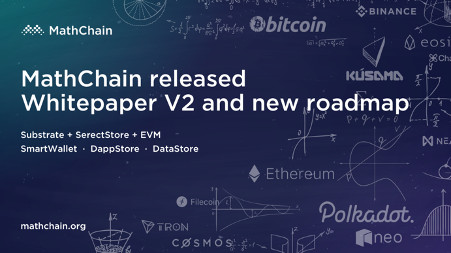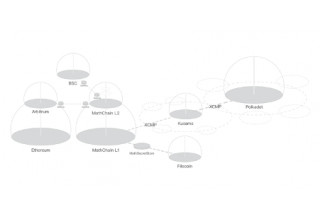SINGAPORE - April 7, 2021 - (Newswire.com)
MATH Global Foundation, the Singapore based foundation behind the development of MathWallet, has developed MathChain, a Layer 2 blockchain based on substrate that is a foundational piece of MATH's plan to build a multi-chain asset hub.
The crypto market has been very hot this past year: multiple cryptocurrencies have traded at all-time highs, and popular brands like Tesla and PayPal enabling cryptocurrency transactions has helped to drive more mainstream users to embrace cryptocurrency. At the same time, entry barriers still exist. MATH has identified these barriers and ways to eliminate them for the ease of mainstream consumer adoption.
It is worth noting that although adoption of Ethereum has proven the value of DeFi, DeFi on Ethereum can be likened to Mercedes-Benz and BMW in traditional car companies: luxury products bought by the rich, but merely an aspirational dream for the average user. Looking at history, the biggest and most competitive market has been the mass market, where the products made by Volkswagen, Toyota, Ford and others are sold in large volume to serve the everyday needs of most consumers. Reflecting back on the blockchain world, there is an unmet demand for various Layer2 networks whose target users are everyday people. This is the main reason why MATH started the MathChain Layer2 blockchain network.
MathChain has three main objectives:
1. MathChain is committed to reducing the entry threshold for ordinary users. For example, the existing mnemonic or private key is just like a car with a manual transmission, in that it requires a person to practice in order to know how to operate it and drive safely, and each one is slightly different to drive. This creates a large entry barrier for most users that are simply looking to get themselves (or their transactions) from point A to point B. The team at MATH believes there is an easier way, an "automatic transmission" for crypto wallets: called the SmartChain Wallet. With SmartChain Wallet, MATH is building a SecretStore module on MathChain which will allow new crypto users to create a decentralized wallet with their social platform accounts.
2. MathChain is committed to supporting multi-chains and can connect to all Layer2 networks. These provide a solution similar to an automobile service center or gas station: a safe, efficient and easy experience that facilitates the consumer's regular use of their automobile. When users require low latency transactions, MathChain uses Layer2 networks to do just that. Layer2 networks improves the user experience in a number of ways, through a product called MathHub. MathHub allows users to leverage the cross-chain capability to exchange different chain assets on MathChain.
3. MathChain is committed to reducing transaction fees to make them more easily affordable for ordinary users. Polkadot's NPoS protocol enables MathChain to significantly reduce fees while maintaining transaction speed. To continue the gas station analogy, this is the difference between having to write a check each time you fill your tank versus simply tapping your contactless payment method. The transaction is quicker, more secure, and verified. The solution, MathPay, will empower MathChain users to use their smart wallet in daily life payment scenarios.
MATH's work to achieve these goals is built upon a strong foundation that includes many years of blockchain project technical and operational experience, as well as a user base of over one million.
Polkadot is another important cornerstone for the MATH team. The agility of the Substrate framework enables MathChain to retain the functions which the smart wallet originally had to accomplish for smart contracts. The mechanism of parachain sharing security of the Polkadot network is the guarantee of the system, while the native support of cross-chain protocol enables MathChain to complete cross-chain connections.
It's helpful to briefly walk through the most distinctive module of MathChain: SecretStore. An extension of Parity, it was originally developed on Ethereum, mainly realizing distributed key management based on Ethereum nodes. The MathChain team is updating its Substrate version, which is similar in structure to Substrate's Offchain Worker module: where Offchain Worker is responsible for oracle data interaction and SecretStore is responsible for automatic distributed management of keys.
MATH is simultaneously developing a smart wallet based on MathChain, which offers a number of features: it does not require users to use private keys or mnemonic words; it supports account backup and retrieval through social media accounts; and it also supports on-chain address management, lockup, domain name management and other functions. It is multi-chain supported, too. MathChain only provides support for the account key management layer.
In addition, MATH Global Foundation is designing PolkaVault, a data wallet based on MathChain and Filecoin. The data wallet is the future of crypto wallets. Wallets will not only store tokens but also personal data, thus truly becoming an individual's digital asset terminal. PolkaVault will create a "bank" for personal data by combining MathChain's encryption permission management with a storage network provided by Filecoin. The MATH team believes that data storage and exchange will become a breakthrough use case for blockchain in the everyday lives of ordinary users.
MathChain also provides support for an EMV environment called MathChain L2, which will bring more product innovations from MathChain, including cross-chain hubs and DeFi products based on smart wallets or data wallets. Many of the best practices on Ethereum can be reused and innovated on in MathChain L2.
MathChain has released the Testnet Galois, and MATH welcomes the community to participate in the MathChain Testnet. They will soon launch the community testnet node event and provide treasury incentives. Later on, MATH will airdrop to the MathChain addresses of MathWallet Polkadot users.
The final blueprint of blockchain is like many interconnected cities, where each city will gradually develop its own ecosystem and residents, as well as have its own governance system. The MATH Global Foundation believes that MathChain will be the first stop for ordinary users entering the blockchain world.
"We believe that MathChain will be the bridge between Web 2.0 and Web 3.0, lowering the barriers for new crypto users and also rebuilding the basic infrastructure of wallets, appstores, and "datastores" in the new Web 3.0 metaverse," says MathWallet CTO Eric Yu.
About MathWallet
MathWallet is a multi-platform (mobile/desktop/hardware) universal crypto wallet that: enables token storage of 60+ chains including BTC, ETH, Polkadot, Filecoin, Solana, BinanceChain etc; and supports cross-chain token exchange, multi-chain dApp store and operates nodes for POS chain. Investors include Fenbushi Capital, Alameda Research, Binance Labs, Fundamental Labs, Multicoin Capital, NGC Ventures.
Media Contact: mikechi@mathwallet.org
Related Images
Press Release Service by Newswire.com
Original Source: MathChain: Build the Blockchain Infrastructure for Mass Adoption
















